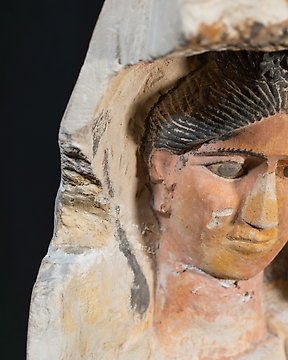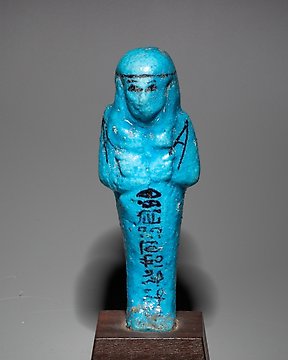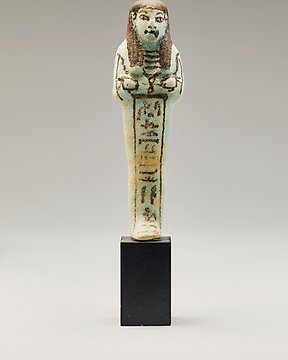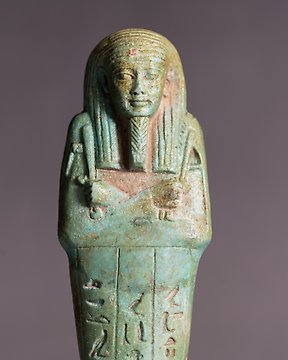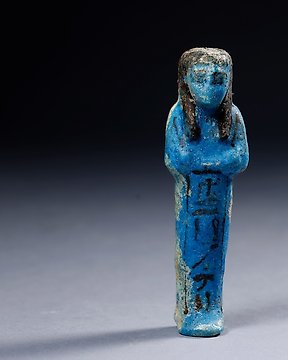Wunderbares Stück. Alles wie beschrieben. Hervorragender Kontakt.
Übersetzung ansehenAltägyptisch Fayence Amulett der Göttin Sachmet. Spätzeit, 664 - 323 v. Chr. 7 cm H. Spanische Exportlizenz.
Nr. 85410341
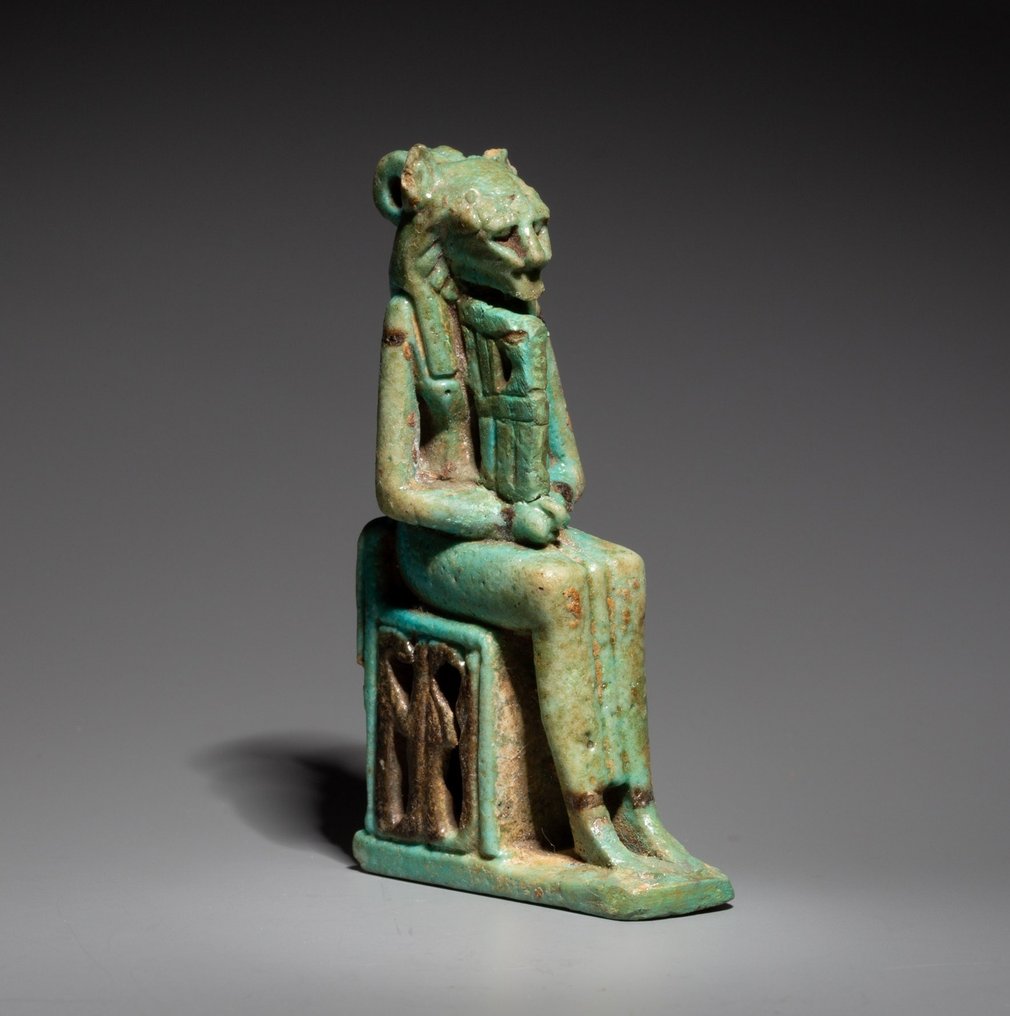

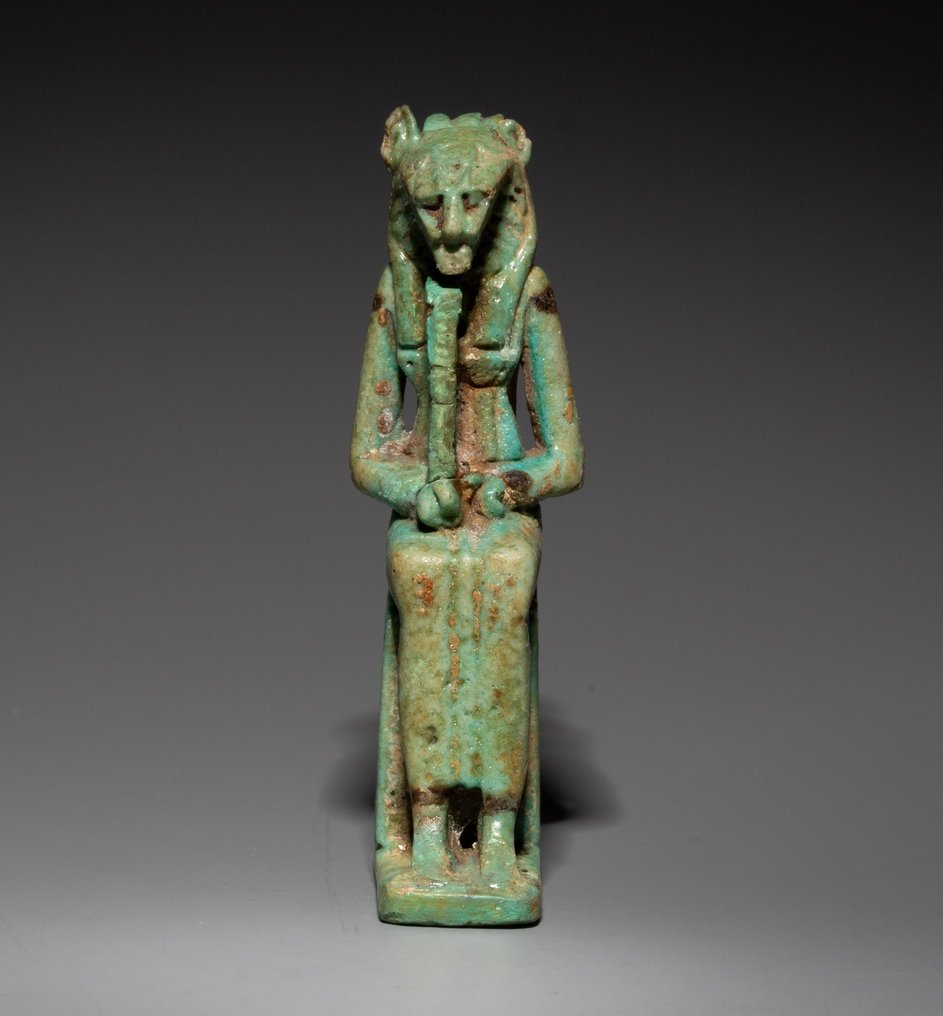
Amulet of the goddess Sekhmet
CULTURE: Ancient Egypt
PERIOD: Late Period 664 - 323 BC.
MATERIAL: Faience
DIMENSIONS: Height 7 cm
PROVENANCE: Private collection, Dunfermline, United Kingdom. 1960 - 1970
CONDITION: Good overall condition, restored toe tips, and restored break line at waist.
DESCRIPTION:
An image of the Egyptian feline goddess Sekhmet. As is common in Egyptian art, the goddess is seen with the body of a human and the head of an animal. The body is that of a young slender woman wearing a long tunic clinging to her figure. Only the arms and the feet are uncovered. The head is that of a lion. This hybrid figure is seated on a throne with a low backrest the sides of which are decorated with snakes representing Nehebkau, a primordial divinity of abundant and nutritive nature, a protector of royalty. On the back of the throne we find the ankh symbol, the cross commonly known as the “key of life”. This could only be carried by gods, goddesses and deceased kings (who after death became divine). Sekhmet is holding a sistrum in her left hand just below the breast. The right arm is resting on her thighs.
The pointy muzzle of the feline takes the place of a human face. The substitution of the mane by a human wig seems almost natural. The working of Sekhmet’s throne was done using a technique widely used at the end of the New Kingdom for faience work which is called “openwork”. Once the figure has been modelled, the necessary empty spaces are hollowed out with a sharpened knife. Despite the fragility and delicate nature of the piece, this amulet is an excellent state of preservation. The surface has kept part of its original intense turquoise colour. Even given the small size of the piece, the quality of the craftsmanship is excellent: the anatomical details, the eyes, eyebrows, nose and mouth have been rendered with precision.
Representations of the goddess Sekhmet were very popular during the Third Intermediate Period, when the Egyptian religion evolved into regional religions and into the cult in the home of certain gods protecting the home and the individual. This religious innovation led to a great increase in the production of figurines and amulets of divine protectors such as Bastet, Bes, Patek, Tauret, Nehebkau, etc.
According to some studies the form of the ears would indicate if the statuette is a representation of Bes (who has cat-like pointy ears) or Sekhmet (who has rounded ears like a lion). As this is simply a theory, such pieces can be identified as either of the deities or both combined in one.
Sekhmet, Sejmet or Sachmis, was given titles such as “the (one who is) powerful” and “Mistress of Dread”. She was a symbol of power and force. She was a protector goddess of the pharaohs, and led them in warfare. She was considered a goddess of war and of vengeance, but at the same time goddess of healing. This dual identity is associated with the cat goddess Bastet, and this would be the image of Sekhmet when she was calm and at rest. Bastet is the gentle goddess, the lady protector against illnesses, patron of the priests, protector of women in labour and of children. Sekhmet is also represented with the solar disk headdress like the goddess Hathor, due to her being recognised as the daughter of the sun god Ra and his sun cult.
Sekhmet was worshipped as the “Lady of Asheru” in the temple of Mut in Karnak. She was also worshipped in Luxor, Memphis, Letopolis and the Delta region. In some temples animals were sacrificed and their blood was offered to keep cholera away. The priests performed a ritual before a different statue of the goddess every day of the year to placate her wrath. This is the reason why so many images of the goddess are still preserved. Most of the statues do not exhibit any expression or dynamism, but rather the typical hieratic attitude of Egyptian art. It is estimated that more than 700 statues of Sekhmet stood in the Temple of Amenhotep III in Luxor and in the Karnak Temple. The majority of the effigies found were sculpted during the reign of this pharaoh. Tame lions were kept in temples dedicated to Sekhmet in Leonopolis.
The material used for the creation of this amulet is faience, composed of fine sand cemented with sodium carbonate and sodium bicarbonate extracted from natron. Fired at 950 ºC, the mixture gives an enamel-like finish with the carbonates forming a vitreous surface. It was a simple procedure and therefore not costly. The green and blue tones were achieved by the addition of a few grams of copper oxide extracted from malachite or azurite. The red tones were achieved with iron oxide, the intense blues with cobalt, the black by mixing iron oxide and magnesium oxide with water. All that was needed was to paint the chosen details in the selected colour with a brush before the firing.
Notes:
The seller guarantees that he acquired this piece according to all national and international laws related to the ownership of cultural property. Provenance statement seen by Catawiki.
The seller will take care that any necessary permits, like an export license will be arranged, he will inform the buyer about the status of it if this takes more than a few days.
The piece includes authenticity certificate.
The piece includes Spanish Export License.
THE MINISTRY OF CULTURE FROM SPAIN ASKS ALL SELLERS FOR INVOICES OR OTHER DOCUMENTATION ABLE TO PROVE THE LEGALITY OF EACH ITEM BEFORE PROVIDING AN IMPORT OR EXPORT LICENSE.
#ancientcivilisations
Der Verkäufer stellt sich vor
Amulet of the goddess Sekhmet
CULTURE: Ancient Egypt
PERIOD: Late Period 664 - 323 BC.
MATERIAL: Faience
DIMENSIONS: Height 7 cm
PROVENANCE: Private collection, Dunfermline, United Kingdom. 1960 - 1970
CONDITION: Good overall condition, restored toe tips, and restored break line at waist.
DESCRIPTION:
An image of the Egyptian feline goddess Sekhmet. As is common in Egyptian art, the goddess is seen with the body of a human and the head of an animal. The body is that of a young slender woman wearing a long tunic clinging to her figure. Only the arms and the feet are uncovered. The head is that of a lion. This hybrid figure is seated on a throne with a low backrest the sides of which are decorated with snakes representing Nehebkau, a primordial divinity of abundant and nutritive nature, a protector of royalty. On the back of the throne we find the ankh symbol, the cross commonly known as the “key of life”. This could only be carried by gods, goddesses and deceased kings (who after death became divine). Sekhmet is holding a sistrum in her left hand just below the breast. The right arm is resting on her thighs.
The pointy muzzle of the feline takes the place of a human face. The substitution of the mane by a human wig seems almost natural. The working of Sekhmet’s throne was done using a technique widely used at the end of the New Kingdom for faience work which is called “openwork”. Once the figure has been modelled, the necessary empty spaces are hollowed out with a sharpened knife. Despite the fragility and delicate nature of the piece, this amulet is an excellent state of preservation. The surface has kept part of its original intense turquoise colour. Even given the small size of the piece, the quality of the craftsmanship is excellent: the anatomical details, the eyes, eyebrows, nose and mouth have been rendered with precision.
Representations of the goddess Sekhmet were very popular during the Third Intermediate Period, when the Egyptian religion evolved into regional religions and into the cult in the home of certain gods protecting the home and the individual. This religious innovation led to a great increase in the production of figurines and amulets of divine protectors such as Bastet, Bes, Patek, Tauret, Nehebkau, etc.
According to some studies the form of the ears would indicate if the statuette is a representation of Bes (who has cat-like pointy ears) or Sekhmet (who has rounded ears like a lion). As this is simply a theory, such pieces can be identified as either of the deities or both combined in one.
Sekhmet, Sejmet or Sachmis, was given titles such as “the (one who is) powerful” and “Mistress of Dread”. She was a symbol of power and force. She was a protector goddess of the pharaohs, and led them in warfare. She was considered a goddess of war and of vengeance, but at the same time goddess of healing. This dual identity is associated with the cat goddess Bastet, and this would be the image of Sekhmet when she was calm and at rest. Bastet is the gentle goddess, the lady protector against illnesses, patron of the priests, protector of women in labour and of children. Sekhmet is also represented with the solar disk headdress like the goddess Hathor, due to her being recognised as the daughter of the sun god Ra and his sun cult.
Sekhmet was worshipped as the “Lady of Asheru” in the temple of Mut in Karnak. She was also worshipped in Luxor, Memphis, Letopolis and the Delta region. In some temples animals were sacrificed and their blood was offered to keep cholera away. The priests performed a ritual before a different statue of the goddess every day of the year to placate her wrath. This is the reason why so many images of the goddess are still preserved. Most of the statues do not exhibit any expression or dynamism, but rather the typical hieratic attitude of Egyptian art. It is estimated that more than 700 statues of Sekhmet stood in the Temple of Amenhotep III in Luxor and in the Karnak Temple. The majority of the effigies found were sculpted during the reign of this pharaoh. Tame lions were kept in temples dedicated to Sekhmet in Leonopolis.
The material used for the creation of this amulet is faience, composed of fine sand cemented with sodium carbonate and sodium bicarbonate extracted from natron. Fired at 950 ºC, the mixture gives an enamel-like finish with the carbonates forming a vitreous surface. It was a simple procedure and therefore not costly. The green and blue tones were achieved by the addition of a few grams of copper oxide extracted from malachite or azurite. The red tones were achieved with iron oxide, the intense blues with cobalt, the black by mixing iron oxide and magnesium oxide with water. All that was needed was to paint the chosen details in the selected colour with a brush before the firing.
Notes:
The seller guarantees that he acquired this piece according to all national and international laws related to the ownership of cultural property. Provenance statement seen by Catawiki.
The seller will take care that any necessary permits, like an export license will be arranged, he will inform the buyer about the status of it if this takes more than a few days.
The piece includes authenticity certificate.
The piece includes Spanish Export License.
THE MINISTRY OF CULTURE FROM SPAIN ASKS ALL SELLERS FOR INVOICES OR OTHER DOCUMENTATION ABLE TO PROVE THE LEGALITY OF EACH ITEM BEFORE PROVIDING AN IMPORT OR EXPORT LICENSE.
#ancientcivilisations
Der Verkäufer stellt sich vor
- 752
- 7
- 0
Extremely rapid courrier service from Barcelona to Flanders, picture was nicely and carefully packaged. Muchas gracias!
Übersetzung ansehenVery fine specimen! Thanks.
Übersetzung ansehengoede foto's, goede omschrijving, goed verpakt en snel verzonden.
Übersetzung ansehenmolto bello tutto ok
Übersetzung ansehenPezzo come da descrizione, davvero notevole. Venditore molto consigliato in quanto gentile e disponibile. spedizione molto veloce. Ottimo!
Übersetzung ansehenVenditore davvero ottimo e gentile. Merce come da descrizione, spedizione veloce. Ottimo l'avere certificato di autenticità.
Übersetzung ansehenUn 100 como empresa un 100 como envío . Empresa muy especial con mucha exquisitez en todos los productos y en personal . Muchas gracias
Übersetzung ansehenAll well! Thanks.
Übersetzung ansehenVery nice and fine cut little jewel! Well packed too! Thanks!
Übersetzung ansehennice piece and very fast shipping!
Übersetzung ansehenEs una maravilla de moneda, donde se le nota los pasos de los años y me encanta. Servido muy rápido y bien empaquetado. Con su certificación. Qué más se puede pedir?
Übersetzung ansehenSnelle en correcte levering, alleen was de verpakking voor het schilderij niet stevig genoeg.
Übersetzung ansehenHerzlichen Dank!
Übersetzung ansehenAll OK and with very fast shipping.
Übersetzung ansehenPrachtig schilderij. Zo blij mee. Zeer nette verkoper en zeer snelle levering.
Übersetzung ansehenperfect ! very fast and high quality delivery !
Übersetzung ansehenAll well! Thanks.
Übersetzung ansehenVendeur très professionnel, top +++×
Übersetzung ansehenPhotos trop contrastées pour bien percevoir les défauts, mais ces défauts étaient visibles pour autant. Le "Bon état" est trompeur. Sinon, envoi rapide et correctement emballé. Frais de port exagérés.
Übersetzung ansehenGreat communication, delivery and product. Came with a well made certificate of authenticity and good packaging. Overall very happy with the purchase! Delivery is a bit expensive, but I recommend it
Übersetzung ansehenMagnifique témoin du passé, envoyé avec tous les justificatifs, impeccable. Encore une fois très satisfait, un grand merci
Übersetzung ansehenThank you for the Special offer and the fast shipping of this excellent piece of art!
Übersetzung ansehenvery good description of the object, very good price for this rare item,. Fast sending (has been at my place 2 days after buying!). Definitely would buy again.
Übersetzung ansehen- 752
- 7
- 0
Wunderbares Stück. Alles wie beschrieben. Hervorragender Kontakt.
Übersetzung ansehen